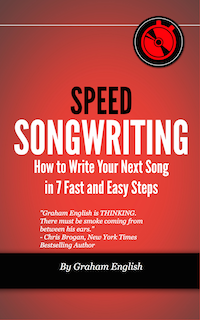
When people think about songwriting, they often imagine creativity as something that flows freely, unrestricted by rules or structure.
However, the truth is that structure doesn’t limit creativity—it amplifies it.
Research in neuroscience shows that organizing information within a clear framework helps the brain solve complex problems more effectively(ScienceDaily)(Frontiers). By giving your song a strong foundation, you free your mind to focus on the most creative aspects of your work, from melody to lyrics. Structure, far from being a constraint, is the tool that unlocks your full songwriting potential.
Let’s examine five key ways structure actually enhances your creativity—and explore a few famous songs that follow a predictable formula while still innovating.
1. Structure Streamlines Your Ideas
One of the biggest hurdles in songwriting is taking a flood of ideas and turning them into something coherent. Structure helps you filter the noise and focus on what matters most.
Think of it like this: if your song were a house, structure would be the blueprint. You wouldn't start building walls before knowing where the foundation goes, right?
The most common song structures (verse-chorus, AABA, etc.) exist because they work. They give your ideas a natural flow.
You can start with a strong verse that sets the stage, drop a catchy chorus to hook your listener, and bring it all home with a bridge or outro that leaves an impact. Once you have this foundation in place, you can focus on innovation within each section—be that through lyrics, melody, or production choices.
2. It Fights Creative Overwhelm
You know that feeling when you’re staring at a blank page and don’t know where to start? That’s creative overwhelm, and it can stop your songwriting dead in its tracks.
But when you use a structure, it breaks the task down into manageable pieces. Instead of being overwhelmed by writing an entire song, you’re just working on a verse. Then a chorus. Then a bridge.
Neuroscience supports this approach—when you work within clear constraints, your brain can focus better, freeing you from the “paralysis by analysis” that often comes with total creative freedom.
Set your roadmap early, and you’ll have the space to focus on polishing each part. The key is simple: stop seeing structure as rigid. See it as a container that holds your creativity and helps it flow.
3. Structure Helps Listeners Connect
Let’s face it: we all crave a sense of familiarity. Whether we realize it or not, listeners respond to patterns, and they do it fast.
A predictable structure makes it easier for people to latch onto your song from the first listen. Think of the most unforgettable choruses—they’re often short, snappy, and repeat at exactly the right times.
This predictability helps the audience feel like they’re part of the song. They know what’s coming, and that connection brings comfort.
Take “Shake It Off” by Taylor Swift as an example. The song sticks to a classic verse-prechorus-chorus-bridge format, but it’s the infectious, repetitive chorus that hooks the listener immediately. Swift didn’t reinvent the wheel with structure; she just made the ride unforgettable by weaving her personality into the familiar framework.
4. It Encourages Innovation (Ironically)
Here’s the funny thing about structure: by narrowing down your options, it pushes you to be more creative within those boundaries.
If you know you’ve got to write a chorus that pops after a specific verse, you’ll dig deeper into your toolkit to make it shine. In the world of art, limitations often fuel innovation.
Picasso once said, “Learn the rules like a pro, so you can break them like an artist.” Songwriting works the same way.
Look at “Hey Ya” by Outkast. On the surface, it follows a fairly simple structure. But what makes it stand out is how Andre 3000 experiments within that structure. The call-and-response hooks, unexpected chord changes, bars of 2/4, and quirky production elevate the track. By sticking to a predictable format, Outkast had room to play with everything else.
5. It Enhances Emotional Impact
A well-structured song guides your listener through a journey, and that journey is what leaves an emotional mark.
Think of structure as the skeleton of your song—the part that holds the weight of the story and emotion. Once you’ve got that framework in place, you can add the flesh: the lyrics, the melody, the production elements. Each section (verse, chorus, bridge) gives you the opportunity to layer emotions and tell a story in a way that connects deeply with your audience.
One perfect example is “Let It Be” by The Beatles. The song follows a simple verse-chorus structure, but the way it builds in emotion is masterful. Paul McCartney starts quietly, and by the time the final tag/coda hits, the swelling instrumentation and vocal harmonies leave the listener with a cathartic release. The structure itself didn’t need to be complex because the song’s emotion grew through the arrangement and dynamics. That’s the power of well-applied structure.
Famous Songs That Followed a Predictable Formula While Still Innovating
Here’s proof that even the biggest artists stick to tried-and-true song structures—and still manage to create something memorable:
- "Shape of You" by Ed Sheeran – This track uses the popular verse-prechorus-chorus-postchorus format, but the innovative marimba riff and dancehall-inspired rhythm make it sound fresh. Sheeran sticks to a familiar structure, but the unique production choices give it a modern twist.
- "Someone Like You" by Adele – A simple piano ballad with a standard verse-prechorus-chorus structure, yet Adele’s vocal delivery and the heart-wrenching lyrical content turn it into something unforgettable. The emotional weight makes the familiar framework resonate.
- "Smells Like Teen Spirit" by Nirvana – A standard pop song structure (verse-prechorus-chorus), yet the raw energy, distorted guitars, and Kurt Cobain’s rebellious delivery turned it into an anthem for a generation.
Ready to Add Structure to Your Songwriting?
The next time you sit down to write, stop thinking of structure as a constraint and start using it as a tool. Here are three steps to get started:
- Choose your structure: Start with something simple like verse-prechorus-chorus-postchorus. Pick the one that feels right for the emotion or story you want to tell.
- Write your sections one at a time: Start with a strong chorus. Don’t try to tackle the whole song at once. Get each part down before moving to the next.
- Experiment within the structure: Once you’ve nailed the basics, find ways to surprise your listener. Maybe you add an unexpected key change or a unique instrument that stands out. Let the structure hold the song together while you explore new creative territory.
Songwriting is subjective, sure. But structure? That’s the secret ingredient that gives your creativity wings.

Enter your first name and email address below and click “GET ACCESS NOW!” to get the Speed Songwriting Cheat Sheet delivered to your inbox!
We guarantee 100% privacy. Your information will not be shared.

Leave a Reply